On 8 May 1945, Norway, together with the rest of Europe, was liberated from the Nazi occupation that had held the country in its grip for five long years.
This digital exhibition documents the days of the liberation in 1945 in Narvik, a small town in Northern Norway that was attacked when Germany invaded Norway on 9 April 1940, and later became the site of Nazi Germany’s first setback, in the Battle of Narvik.
The exhibition consists of photos by Trygve Romsloe and other local photographers, and passages from the diary of Greta Dahl, a local housewife who lived through the occupation and liberation, in addition to some elaborations from our part. Where photograph/ownership is not specified, the photographer is Trygve Romsloe.
Welcome to “Liberated!” A digital exhibition by Narvik War Museum.
Choose a box for more information
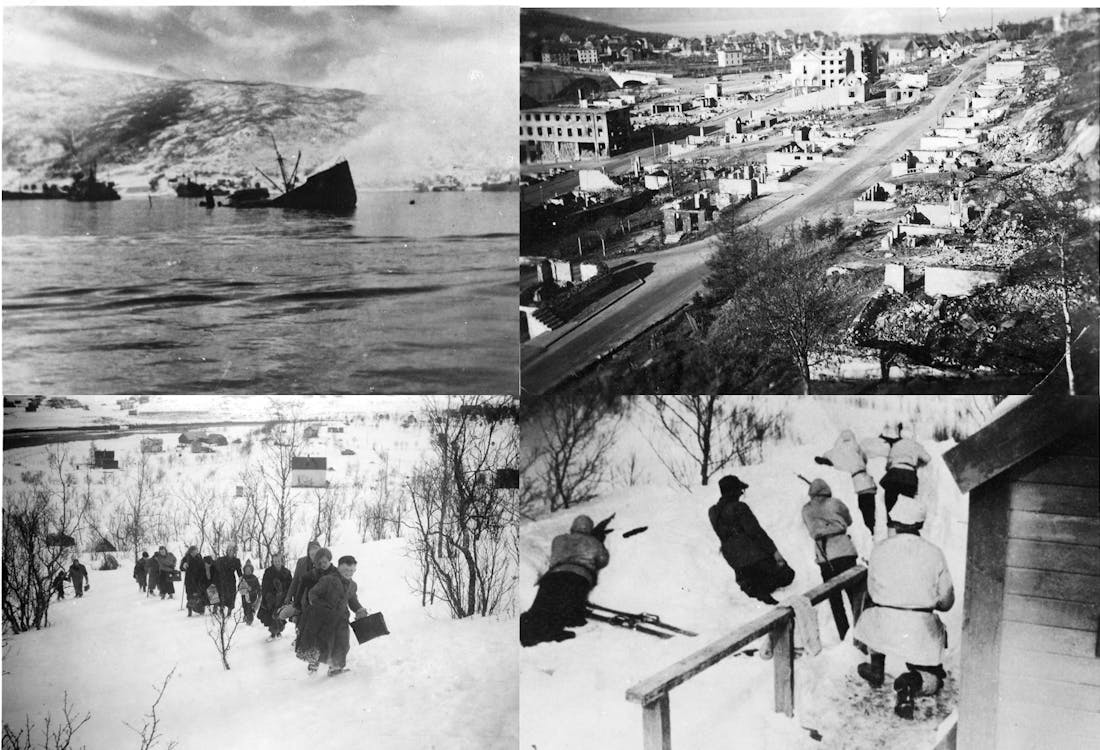
In the spring of 1940, the small town of Narvik in Northern Norway suddenly found itself at the centre of world events. It was a key harbour for the shipment of iron ore from the mines in Northern Sweden, and the European Powers wanted control of it. However, Hitler struck first with the German invasion of Norway on 9 April, in which they managed to capture Narvik and set up a line of defence around the town. In the following days, the British fleet crushed the German warships in two ferocious sea battles in the Ofotfjord right beside the town. Then, for almost two months, Norwegian, British, Polish, and French divisions fought the Germans in the mountains around Narvik. On 28 May, they managed to recapture the town, the first setback the Nazi war machine had encountered so far.
In mid-May the Germans had launched attacks on the Netherlands, Belgium, Luxembourg, and France. The recapture of Narvik therefore became an important symbolic event. Unfortunately, due to the increasing intensity of the war on the continent, the Allies had already decided to redirect their divisions and immediately withdrew from Narvik. Left alone, the Norwegians had to capitulate to the Germans.
This was the beginning of five years of occupation. Years marked by uncertainty, isolation, and rationing, but also civil and military resistance. The occupants were clearly present all over Northern Norway, and Narvik was a communication hub for the German military build-up to the Murmansk front. How would this play out? From 1943, it became obvious that the Allied now had the upper hand. In late autumn 1944, the eastern part of Finnmark county was liberated by the Soviets, while the rest of Norway still had to wait.
On 30 April 1945, Adolf Hitler killed himself in Berlin. On 7 May, Nazi-Germany capitulated. The following day the news spread like wildfire across Europe. In Norway, 350,000 German soldiers were awaiting orders. The Narvik Campaign, the Battle of Narvik in 1940, had cost 8500 lives – what would be the price for liberation?
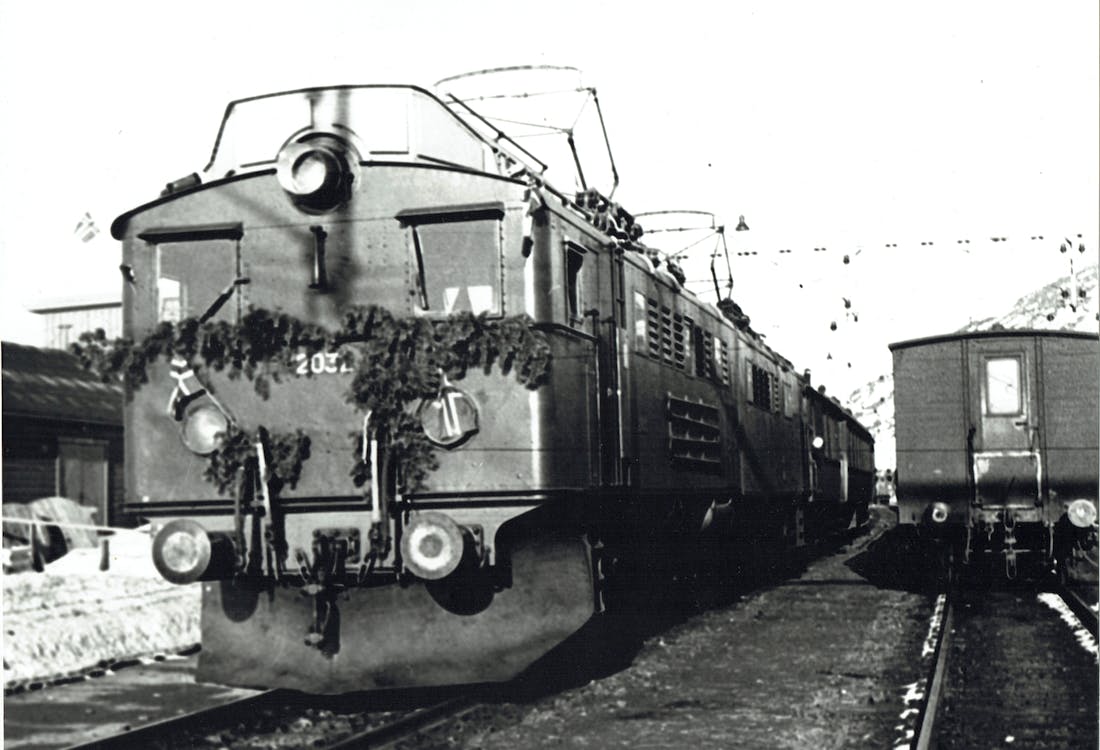
Five years ago, he participated in the recapture of Narvik from the Germans. The joy was short-lived. Now Lieutenant Eirik Coucheron-Jarl is once again headed towards his hometown for the final victory over the Nazis. Hitler is dead and his empire is about to collapse. Germany is expected to announce their capitulation within a few days, maybe hours. For the last two years, Coucheron-Jarl has been in England preparing for the liberation of Norway. He is part of the staff of the district command for Northern Norway under Colonel Otto Munthe-Kaas, one of the officers from the Battle of Narvik in 1940. Yesterday, they landed in Stockholm by plane, tomorrow the journey to the north continues by train. Narvik is waiting. It is time to close the circle.
…“Rumours of capitulation are in the air. At 12 PM it was reported in a Danish broadcast, at 3 PM a Norwegian broadcast said that Terboven has not officially capitulated, and that Böhm the Commander-in-Chief in Norway had asked to capitulate unconditionally.” (Diary of Greta Dahl, 6 May 1945)
Klikk for større bilder

Street 3 and 4 seen from Street 2 (Photo: Trygve Romsloe)
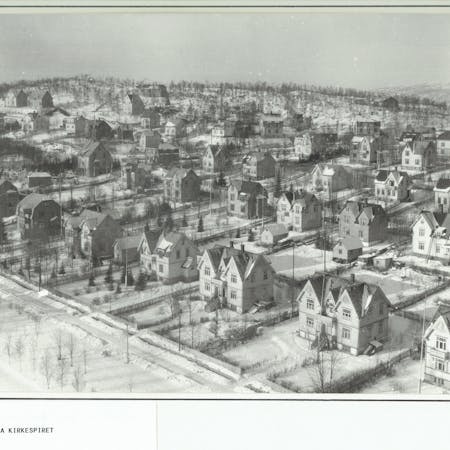
View from the church spire (Photo: Trygve Romsloe)
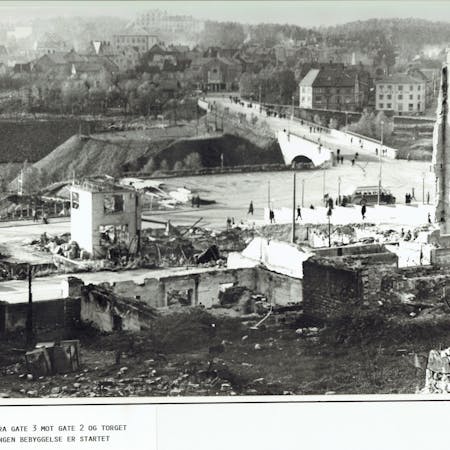
View from Street 3 towards Street 2 and the town square (Photo: Trygve Romsloe)
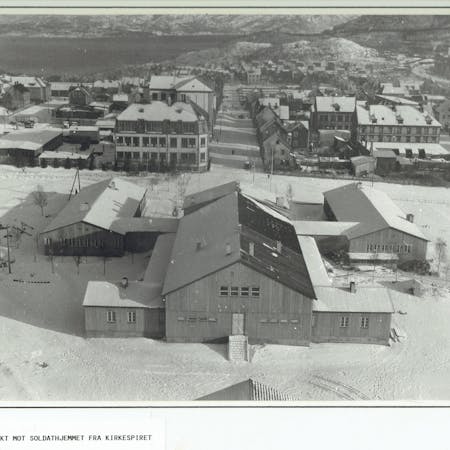
View of the Soldier’s Home from the church spire (Photo: Trygve Romsloe)
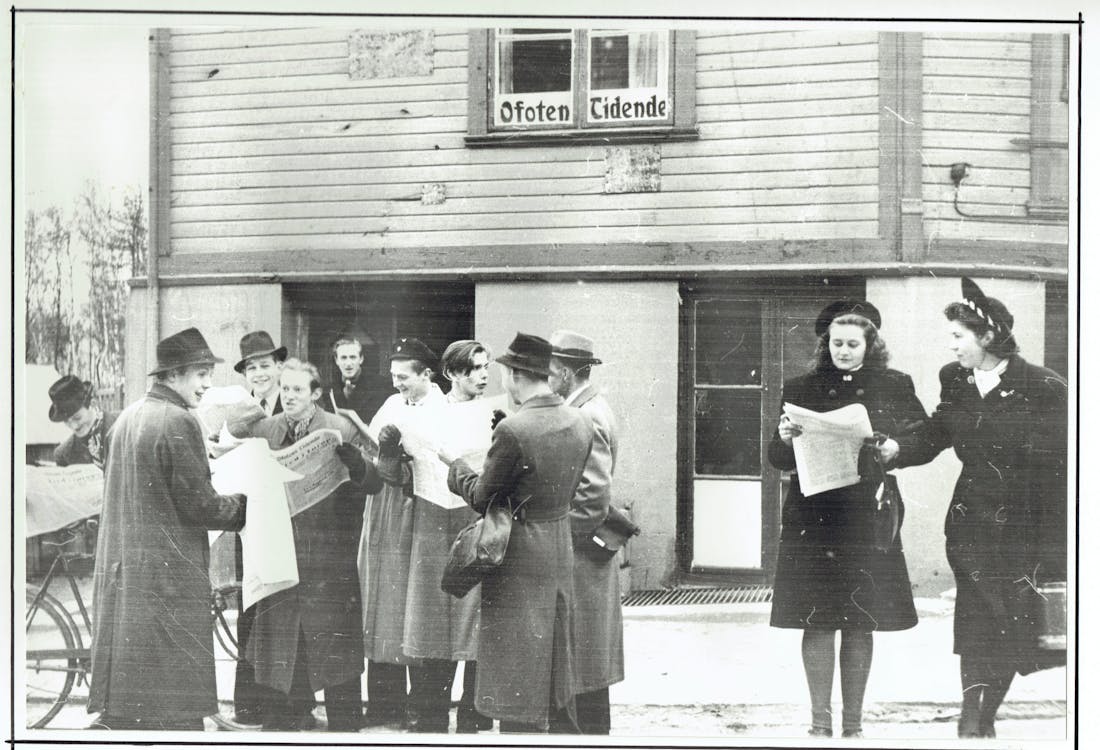
Germany has capitulated! The newspapers report of peace in Europe! People are hugging, crying, and laughing with joy all at once. Spring has arrived, and with it the promise of a brighter future. But in Narvik the Germans do not put down their weapons; they seem excited and agitated. Is it a sign of approval or of a desperate final fight?
Aboard the train through Sweden, the District Commando for Northern Norway receives news of Nazi Germany’s unconditional capitulation on the continent. They too are not sure how the occupants in Norway will handle the news. Are there anyone among the staff willing to travel ahead to Narvik and clarify the Germans’ position, and contact the Head of the Resistance Movement in the Narvik region, Chief Physician Erling Borch-Johnsen? Lieutenant Eirik Coucheron-Jarl, a Narvik native, immediately volunteers.
Hiding his military uniform under a regular coat, he is able to cross the border at Bjørnfjell and hitch a ride with a locomotive into town. A few hours later he arrives in Narvik. He barely manages to call his contacts before he is interned by the Germans.
“It feels as if the line between day and night has blurred. I did not get much sleep last night. People have been wandering up and down the streets all night. It is only 8 AM now and Arild is already out. He went to get the newspaper and ask for the latest news. Oh, how the men are cursing and swearing over giving away the radios. The Soviet prisoners are jumping and dancing and smoking cigarettes.”
“The shop ladies at Brekke had decorated the kids when they came asking for flags. So now they are wandering around like small Christmas threes. Just such a shame that we don’t have anything tasty to give them. I don’t even have a grain of flour, so I could make a peace cake. At least I’m not the only one.” (Diary of Greta Dahl, 8 May 1945)
Klikk for større bilder
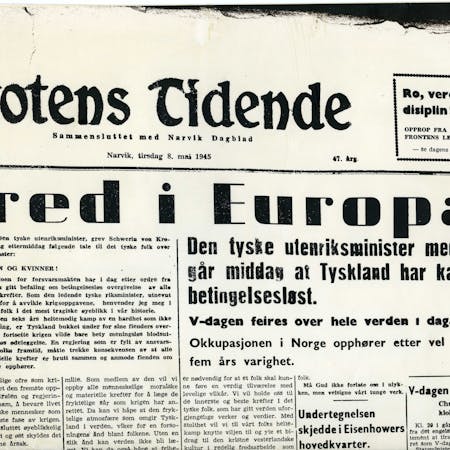
"Peace in Europe." The local newspaper “Ofotens Tidende” brings long awaited news.
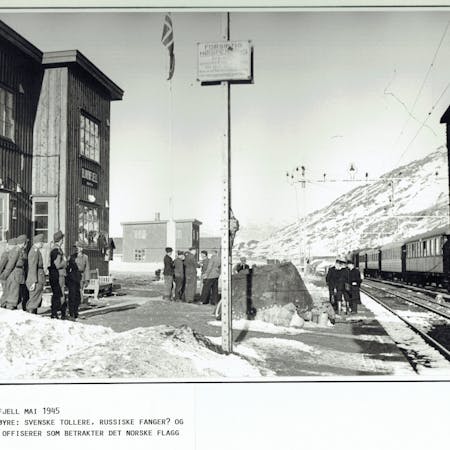
Bjørnfjell in May 1945. From the right: Swedish customs officers, Soviet prisoners, and German officers taking in the view of the Norwegian flag (Photo: Trygve Romsloe)
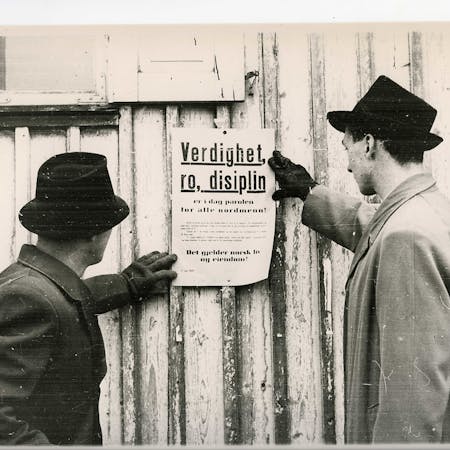
Proclamation from the leadership of the Resistance Movement, 8 May 1945 (Photo: Narvik War Museum)
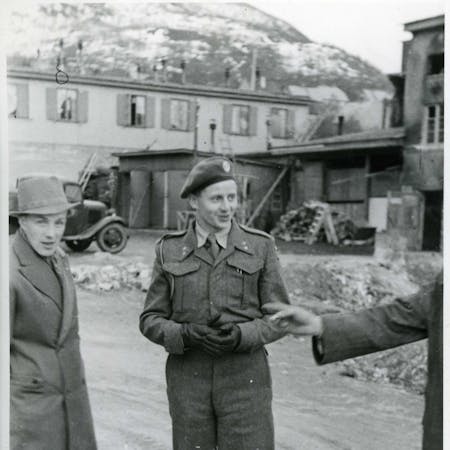
Lieutenant Eirik Coucheron-Jarl volunteered to travel ahead to Narvik and clarify the German occupant’s position regarding the capitulation (Photo: Narvik War Museum)
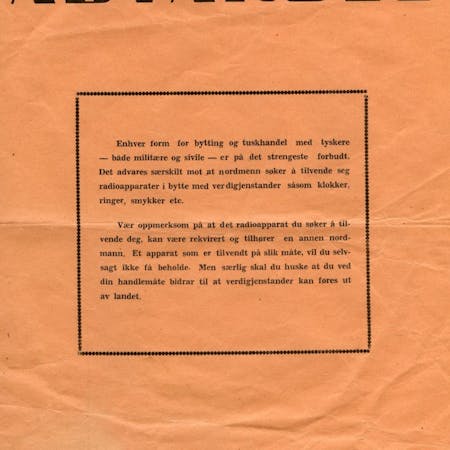
Norwegians are warned against trading with Germans after the capitulation (Photo: Narvik War Museum)
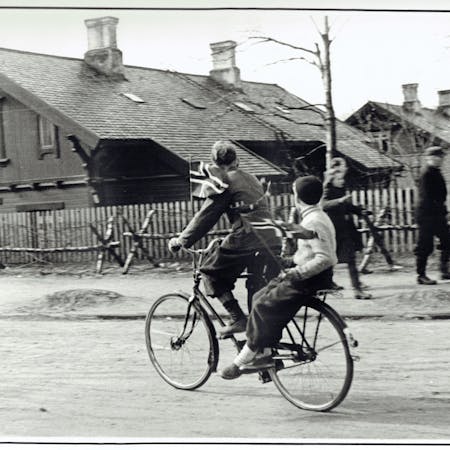
"Elna comes home from school and says there is “peace”, so now they won’t take their exam. They were supposed to have their Norwegian exam today and tomorrow. But hardly any teachers showed up at school and only 7 pupils.” (Diary of Greta Dahl, 7 May1945). Photo: Trygve Romsloe
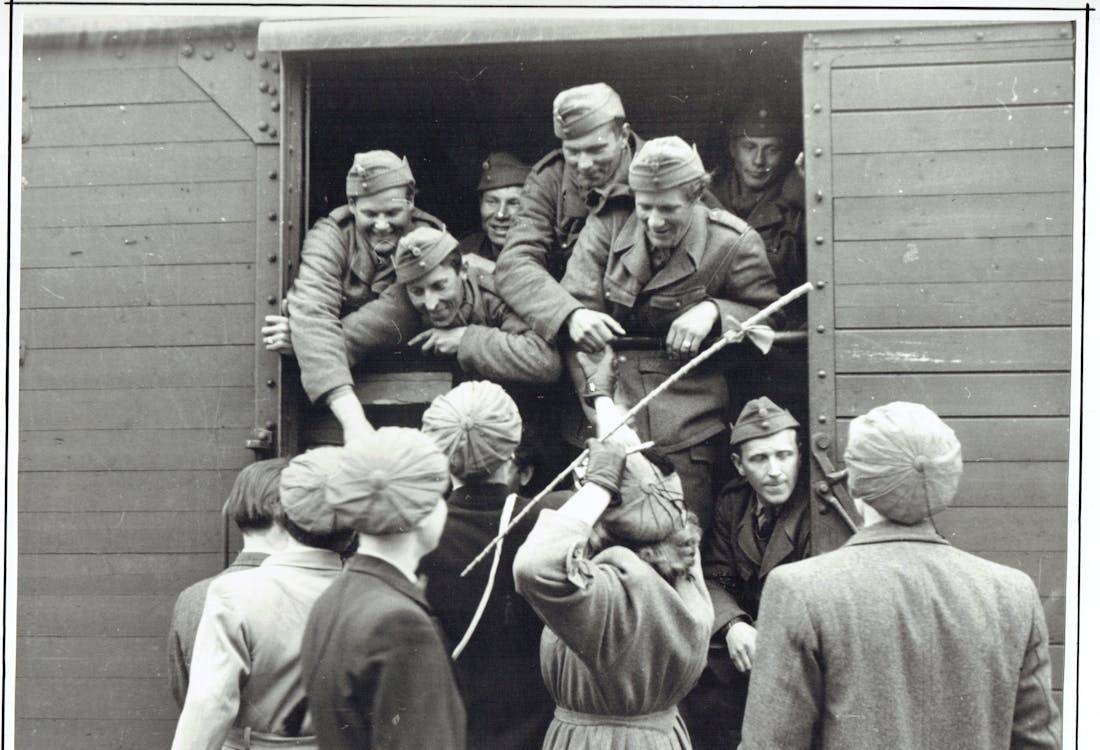
For months and years, the Norwegian police troops in Sweden have prepared for this moment – the end of the war. The police troops were established in 1943 and consist of 15,000 Norwegians of conscription age who fled to Sweden. In fact, they are a military division. Some of them participated in the liberation of Eastern Finnmark a few months prior. Now their task is to maintain peace and order in the first phase of transition after the liberation.
The Germans behave by the book and show no signs of rebellion. The previous day, they have accepted the capitulation and released Lieutenant Eirik Coucheron-Jarl – on his 28th birthday. He can therefore complete his mission and prepare the arrival of the police troops.
The first large group arrives by train from Riksgränsen at the Swedish border in the late afternoon. The train station is decorated with birch twigs and Norwegian flags, the platform filled with merry people. “The whole town” is out celebrating. At 6.45 PM the German Hauptmann Schirach formally surrenders the town to Colonel Munthe-Kaas. Both parties are clearly relieved.
“11 AM. I was stunned when I heard the church bells today. Didn’t remember it was Ascension Day – we have been so preoccupied with these Norwegian soldiers who are coming. Now they say the train will arrive at 2.05 PM. Dinner is less likely to be done by then. I hear the Germans have dumped a lot of the food from the storage in the sea. Some of it they loaded onto two big ships that went to Skjomen to sink the food there. They are making bonfires in several places, burning large bundles of banknotes. New, unused…”
“THEY HAVE ARRIVED. Our boys. By train from Sweden. People were ecstatic. Most of the town’s population will probably be hoarse as ravens tomorrow. Oh, what fun. I was crying and shaking when the marching band played the national anthem and everyone took their hats off. Oh, how we have waited for this moment.” (Diary of Greta Dahl, 10 May 1945)
Klikk for større bilder
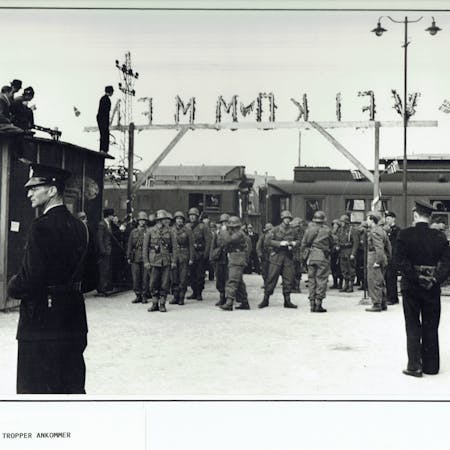
The Norwegian troops are welcomed by “the whole town.” (Photo: Trygve Romsloe)
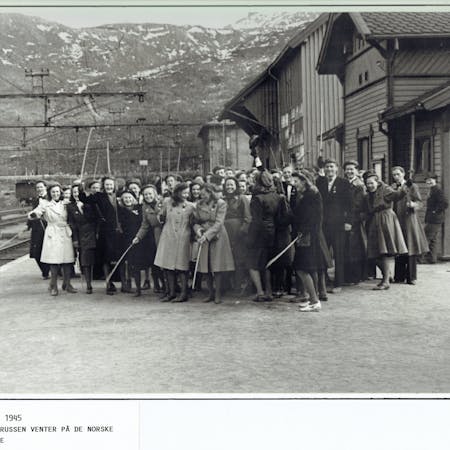
The local high school graduates are waiting for the troops to arrive at the train station (Photo: Trygve Romsloe)
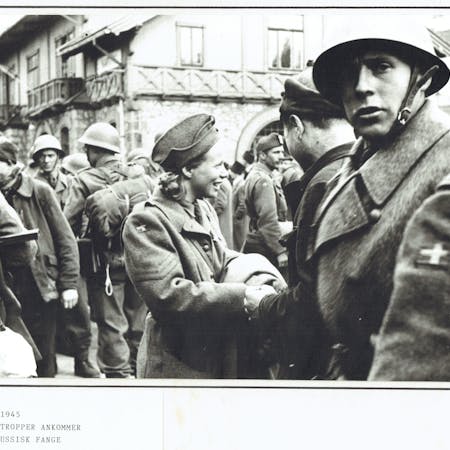
The Norwegian troops arrive. A Soviet prisoner to the left (Photo: Trygve Romsloe)
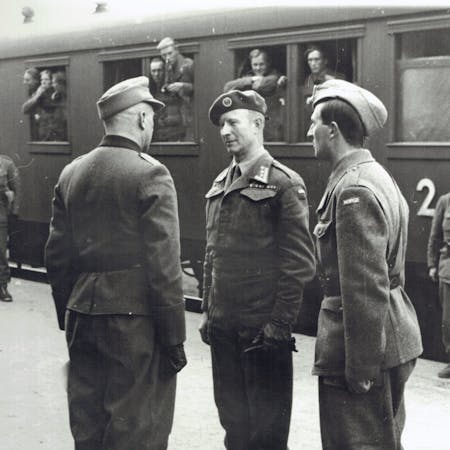
The surrender of Narvik took place at 6.45 PM. The German staff stood in front of the train station waiting, while cheers and singing rose from the platform. Then Colonel Munthe-Kaas went with Adjutant Scheldrup to the German Hauptmann Reischach. The necessary military greetings and formalities were exchanged, and thus the city was handed over to the right hands. Afterwards, Munthe-Kaas went with his staff to the hotel while dense crowds of cheering spectators lined their way. (Photo: Trygve Romsloe)
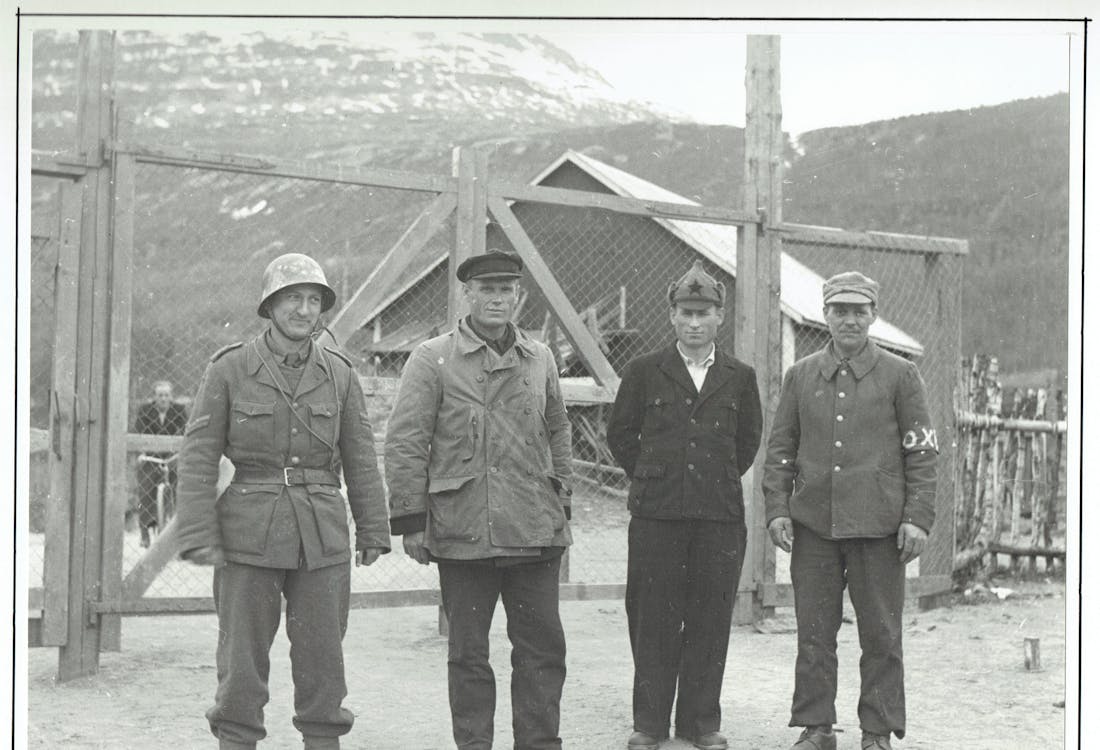
The spark is back in their eyes. The foreign prisoners ravaged by the Germans, many of whom driven to death. The sufferings have been enormous, especially for the Yugoslav prisoners and the Soviet Prisoners of War. There are hundreds, thousands of them in the camps. Some still dying in the infirmaries; the exhaustion is too big. The liberated prisoners need food, but portioned out, so they do not get sick. There are also forced labourers from several other countries: Czechoslovakia, France, Poland. They can hardly believe their torment is over.
Others get no sympathy. Norwegian collaborators, the benevolent helpers of the occupants, are arrested. Another symbol of how the tables have turned is the confiscated radios being returned. Soon, the sounds of freedom are once again heard all over town.
“People can visit the Soviet camp. It’s said to be horrible, despite the Germans trying to clean it up before the Allies’ arrival. There are supposedly about ½ million Soviet prisoners in Norway. Quisling has surrendered. All the other big traitors have been captured, except Jonas Lie and a few others who shot themselves. Himmler has not been captured. Hitler’s body has been found. Goebbels and his family as well. Not many supervillains are left.” (Diary of Greta Dahl, 13 May 1945)
“It would be better if all these liberated prisoners; Serbs, Poles, French, Soviets and all the others could be able to leave immediately while they still have all these happy and friendly people in mind”… “Everyone is smiling at each other. The Soviets salute and say either “vasti” or “mornin'”. You would not think these are the same prisoners who all crooked and worn down dragged themselves through the streets, malnourished, lethargic, and exhausted. Now they are walking upright, all well-groomed, polite, and smiling.” (Diary of Greta Dahl, 19 May 1945)
Klikk for større bilder
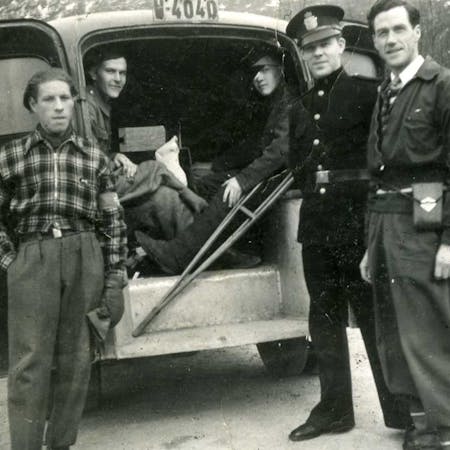
Ingvald Hope (to the right) was arrested by Gestapo and spent 10 days in Beisfjord prison camp in the final days of the war. He was released after the liberation and is here seen on a mission for the Home Forces, who were responsible for infrastructure and supervision of the prison camp. (Photo: Narvik War Museum)
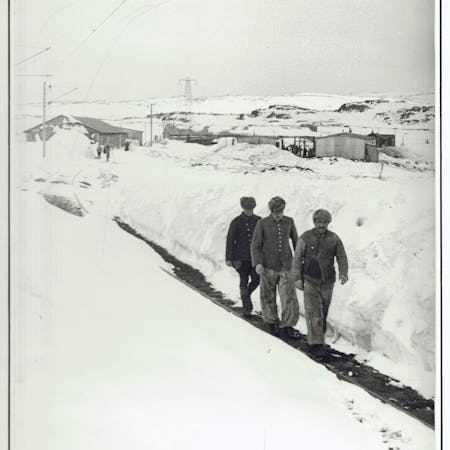
After the liberation, the more than 600 prison camps established on Norwegian soil by the German occupying power are liberated. The largest group of prisoners in Norway during the war, more than 95,000 people, are the Soviet Prisoners of War. Here, freed Soviet POWs by Grusgropa at Bjørnfjell in May 1945. (Photo: Trygve Romsloe)
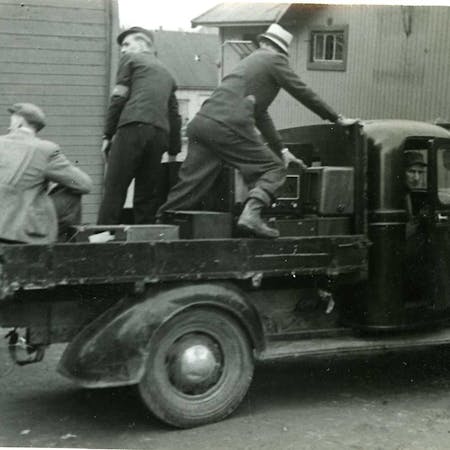
A liberated Norway meant free access to news from far and near. There was great joy when people finally could have their radios back, and not have to risk their lives anymore to listen to news on illegal radios or pass on news in secret. (Photo: Narvik War Museum)
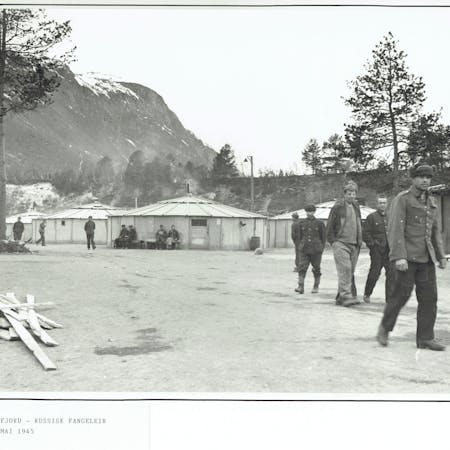
Soviet Prisoners of War with round plywood tents in the background. These were put up as replacement for the barracks which were set on fire by the prison guards on the night of terror 17-18 July 1942, where 287 Yugoslav prisoners were killed. To this day, it is still considered the biggest massacre ever to have taken place on Norwegian soil. Beisfjord prison camp after the opening on 26 May 1945. (Photo: Trygve Romsloe)
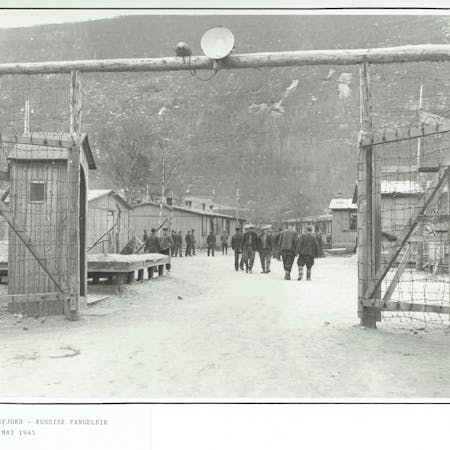
The entrance to Beisfjord prison camp, with open gates on 26 May 1945. There were 1,583 prisoners in the camp at the time. Since 25 October 1942 between 3,500 and 4,000 Soviet Prisoners of War had been in the camp for shorter or longer periods of time. Prior to that, there were 900 Yugoslav prisoners in the camp, of which 784 died within four months. (Photo: Trygve Romsloe)
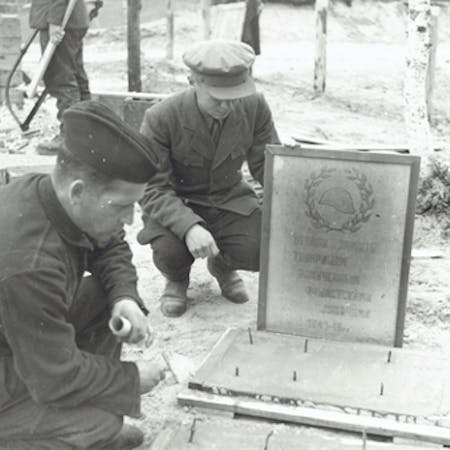
Before the Soviet Prisoners of War left Beisfjord and Narvik, they built a memorial to the 347 of their comrades who perished from disease, hunger, and mistreatment in the Beisfjord prison camp. In the photo work is being done on the foundation and the plaque for the memorial, finished on 6 June 1945. The memorial still stands in the same spot where the prison camp once was. (Photo: Trygve Romsloe)
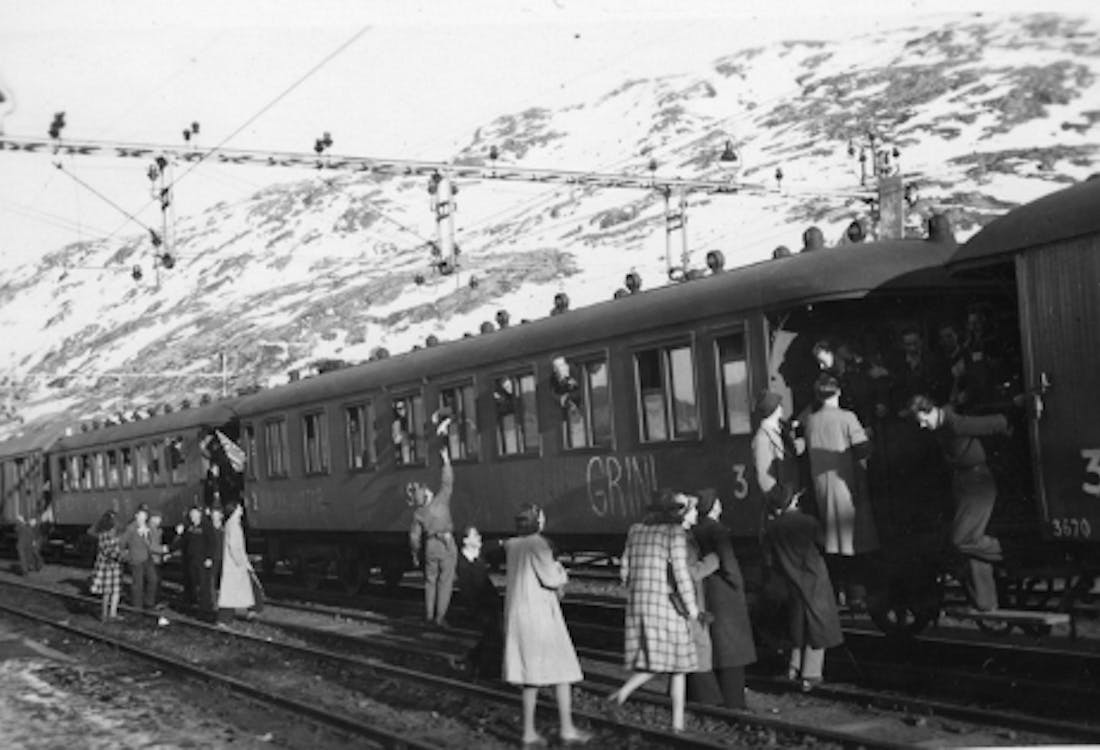
Life resumes and the grip of the iron fist subsides. Confirmations are being held again. Norwegian soldiers in town join efforts to gather crispbread and sweets for the schoolchildren. On the evening of 15 May the union holds a mass gathering to mark the end of “the dark times”. There’s a greatness to the moment that everyone present can sense.
Another big day follows! Finally, they are returning! “The freedom fighters”, those who were arrested during the occupation for disobedience and resistance. They have been imprisoned in camps all over the country; at Krøkerbærsletta and Bardufoss in Troms county, at Falstad in Trøndelag county and Grini outside Oslo. Now they are returning home, freed from the tyranny. People crowd together at the station hours before the train carrying the 188 prisoners from Grini is due to arrive in the evening. The all-male choir sings the song “Northern Norway.”
At the same time, they know that not everyone will see their loved ones again. Some lost their lives in prison.
“Sunny today. Confirmation. Not possible to send confirmation telegrams through the telegraph. We have also been requested to make as few phone calls as possible. So many Norwegian soldiers have arrived here, they have changed the scenery in the streets. Smiling people and smiling soldiers. A continuous string of new events enough to get your head spinning.” (Diary of Greta Dahl, 13 May 1945)
Klikk for større bilder
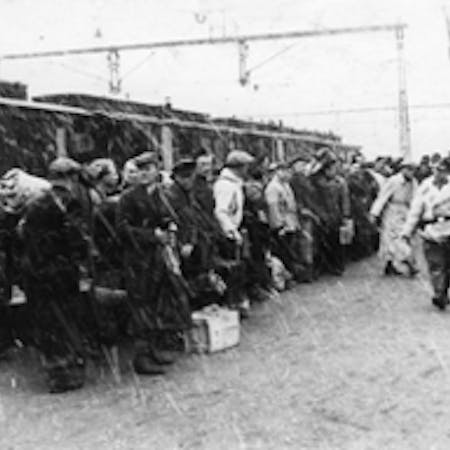
Narvik 8 May 1945, 8 AM. The hated commander of Tromsdalen prison camp, Julius Denzer, ends his service. Denzer has previously served in Grini prison camp, where he was nicknamed “the Circus Clown” because of his vanity. Denzer transported all the Norwegian prisoners to Narvik in the last days of the war, shook each and everyone’s hand thanking them for their cooperation, and then fled the scene. Denzeer was arrested in Germany in 1947, transported to Norway and received a 15-year sentence. (Photo: Narvik War Museum)
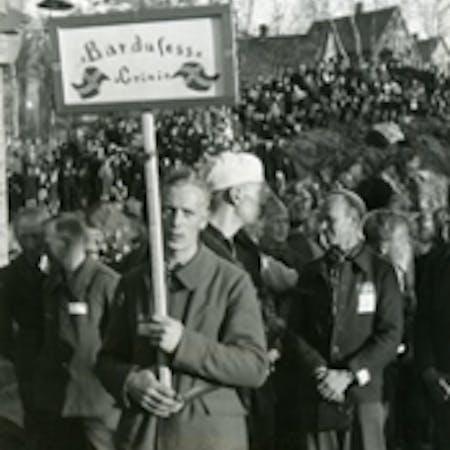
Narvik, 17 May 1945. Released Norwegian prisoners from Bardufoss prison camp take part in the National Day parade. 336 of them are in Narvik waiting for further transportation southwards, and take part in the joy of liberation on the National Day. Most of them have been prisoners at Grini prison camp, before being sent to Bardufoss as forced labourers to work on the extension of the airstrip at Bardufoss airport. (Photo: Narvik War Museum)
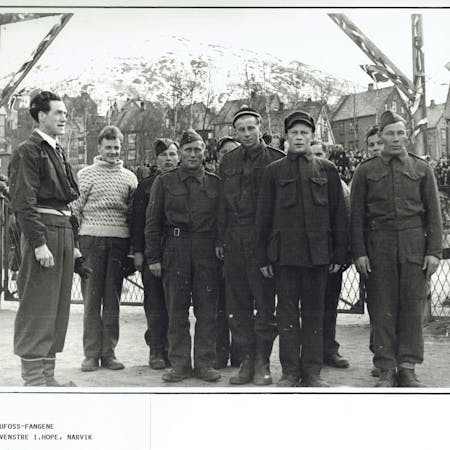
The prisoners from Bardufoss prison camp are also released, much to the relief of friends and family. The wait has been long and uncertain for them. These prisoners were arrested by the occupying power under suspicion of being part of the resistance movement. Some have taken part in large, organized operations, others have refused orders or shown disobedience in various ways. To the left, Ingvald Hope, formerly imprisoned in Beisfjord prison camp. (Photo: Trygve Romsloe)
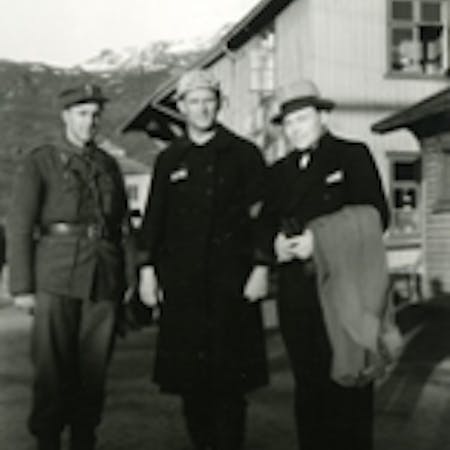
(Photo: Narvik Krigsmuseum)
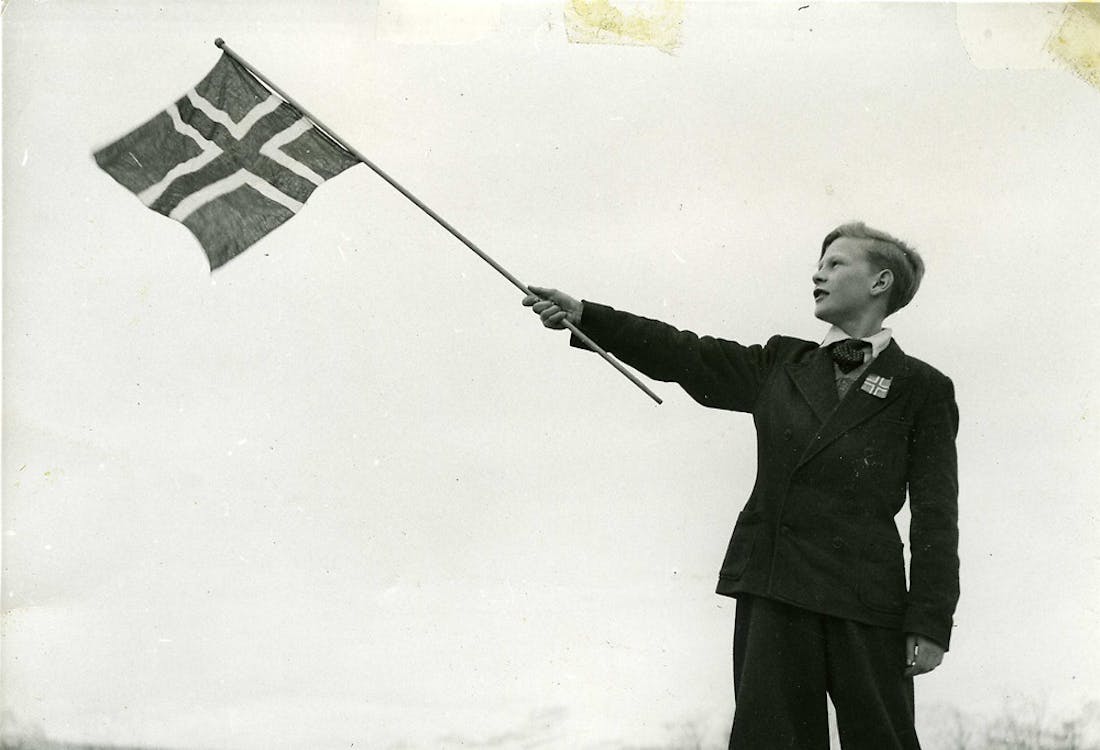
The National Day arrives with glorious weather and the town’s largest children’s parade ever! Parents can once again be carried away by the children’s laughter and joy. Narvik is covered in red, white, and blue, it is a time of rejoice and positive outlook on the future. The parade in the afternoon is so long that it catches up with itself! The banners, the marching bands, the choirs, the scouts, the gymnasts, the high school graduates… All gone for five years, and now they are back! Head of the Resistance Movement in the Narvik region, Chief Physician Erling Borch-Johnsen, is main speaker in the town square. In the town centre the dancing and celebrations continue into the night.
Lieutenant Eirik Coucheron-Jarl has travelled on in service of the country and honours the Norwegian flag in Tromsø. There is an unforgettable atmosphere all over the country.
…”Events one after another. But I will not attempt to write about them. I will just cut and paste from the newspaper. I simply haven’t had the time to write in my journal. We had to be out and about, watching everything that has taken place. And who knew one could get by with so little sleep, I have hardly slept in the last 14 days. But then again, I have been tired – to the point where my head was spinning.” (Diary of Greta Dahl, 19 May 1945)
Klikk for større bilder
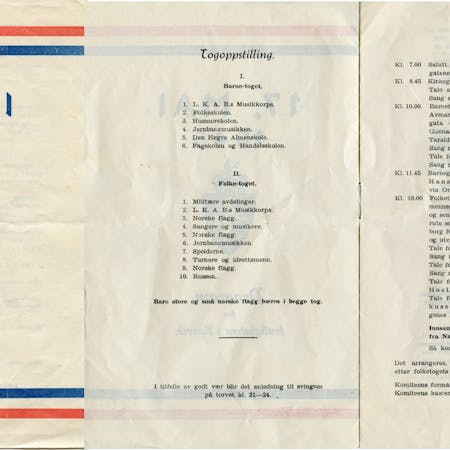
The National Day programme in Narvik. (Narvik War Museum)
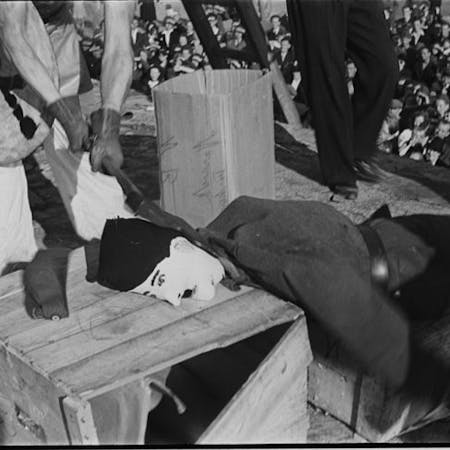
The high school graduates beheaded a doll of Hitler in the town square in Narvik to great cheers by everyone present (Photo: Narvik War Museum). “The high school graduates, of course, left their mark on the day, as before the war, and their afternoon event in the square was good, with a suitable mix of banter and impudence, and no lack of seriousness either. Throughout the evening there was dancing in the town square and a public party in the former German soldiers' home." (Excerpt from the local newspaper "Fremover", 18 May 1945)
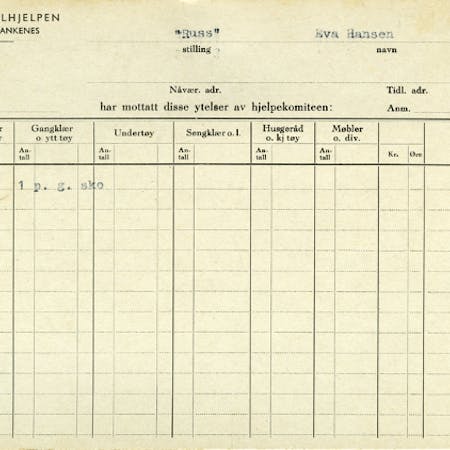
Rationing card of a high school graduate who receives a pair of shoes before the National Day. (Narvik War Museum)

LKAB marching band in front of Narvik Church. (Photo: Trygve Romsloe)
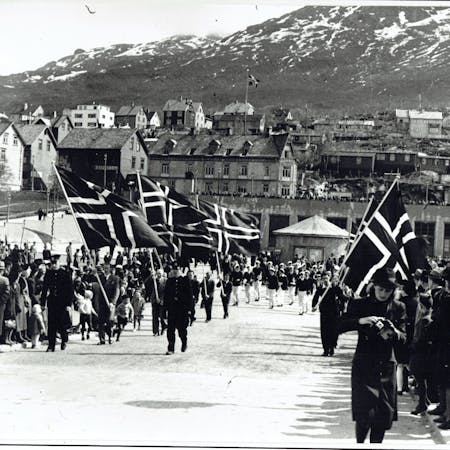
Flag bearers at the head of the parade on the Frydenlund bridge with the town square in the background. (Photo: Trygve Romsloe)
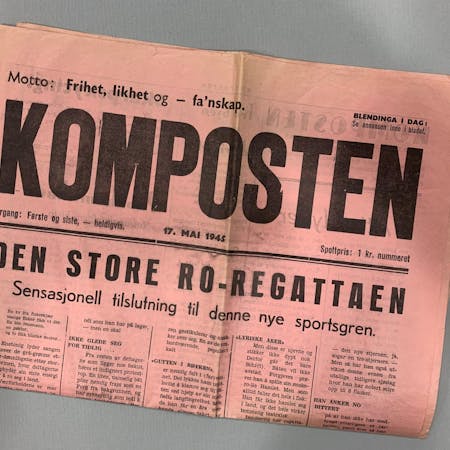
The school paper for the Narvik high school graduates in 1945 (Narvik War Museum). Excerpt from the paper: "The compost. The strange name of this paper may surprise you. “The compost?”, you will repeat with wonder, wrinkling your nose. You will instinctively think of rubbish and waste, of all kinds of rot and filth. But then, my dear reader, you are on the right track. Our newspaper is a section of a rotten society. Don’t you wrinkle your nose too much from the pouring stench. We are just passing on what the times have given us."
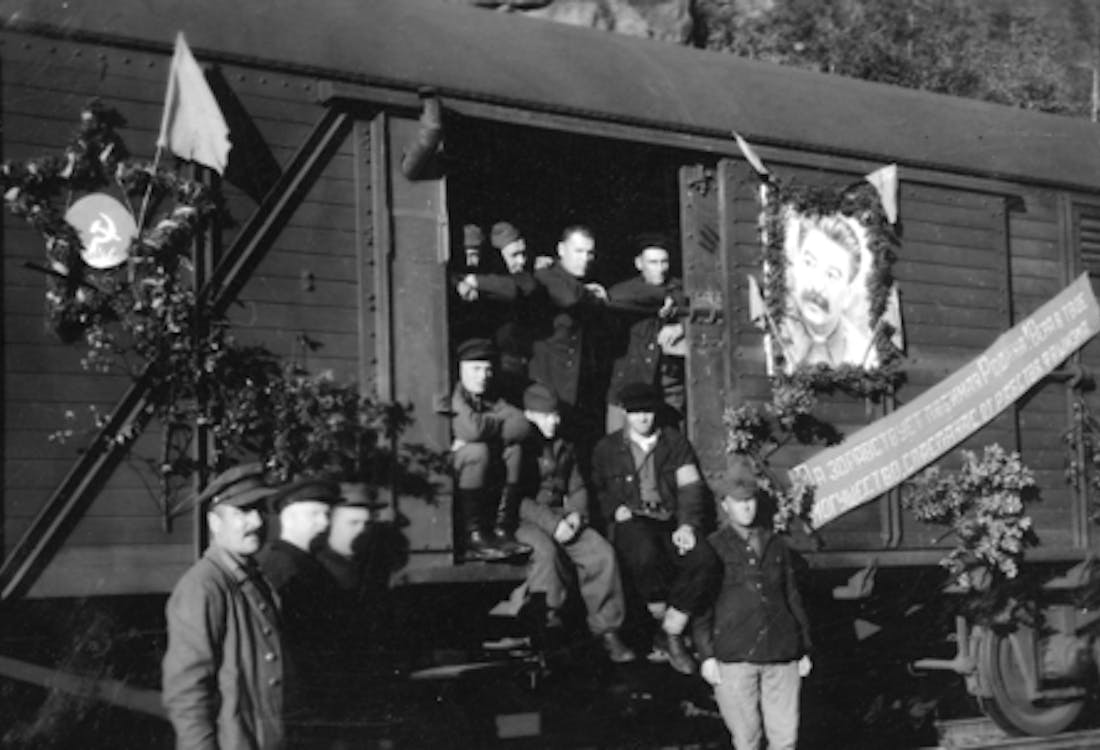
In the Narvik area alone there are 20 camps with 3,500 Soviet Prisoners of War at the time of the liberation. They still have to wait several weeks for repatriation, and in the meantime move further and further from the fences of the camps, exploring and finding their way into freedom once more. Many create tight bonds with the local Norwegians, countless gifts are exchanged, and some even find the love of their life.
They raise memorials to their fallen comrades. But what does the future hold for those who survived? They have no idea. Saying goodbye to the Norwegians brings mixed feelings, but when the day comes, they march to the station in proper order, carrying large pictures of Stalin. The transport goes on for weeks. Many of Narvik’s residents show up to say their final goodbyes to the ex-prisoners. The majority they will never hear from again.
“Every night groups of about 800-900 Soviets go by. People line up everywhere and wave and holler at them. They are led into Kleiva or rather by the large stairs down to the quay. Then they throw biscuits, cigarettes, and sweets to the children are standing along the railway line. They so desperately want to give the Norwegians something. They are a very good-natured people. It was fun getting to know them. But we get the impression of tough discipline. They display exemplary behaviour.”
“Meeting one of the Soviet prisoners with his radiant smile is a joy. Oh, it’s wonderful to experience this time. I wish those who fell at the various fronts could catch a glimpse of this, where they are. The thought of them is the only thing that can darken these sunny days for us. And the thought of their survivors. After all, we are in this world. Even these glorious days have their bitter gleam.” (Diary of Greta Dahl, 26 June 1945)
Klikk for større bilder
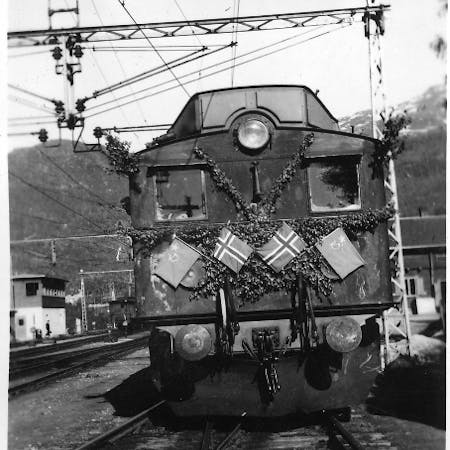
Train decorated with Norwegian and Soviet flags.
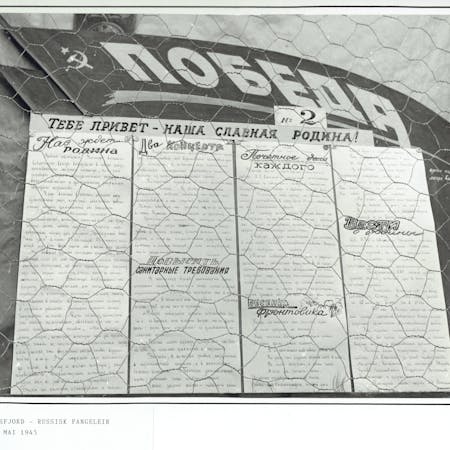
Handwritten wall newspaper made by the Soviet Prisoners of War in Beisfjord prison camp after liberation. It is called “Victory. Greetings to our glorious motherland”. This is the second edition of the paper, and it contains several articles with titles such as "The motherland is waiting for us", "Hygiene conditions must be improved", "Everyone has a duty to follow the rules of order" and "News from the motherland." All topics that concern the newly released POWs. In addition, they have included the lyrics to "The Front Soldier's Song" and announcements of two concerts.
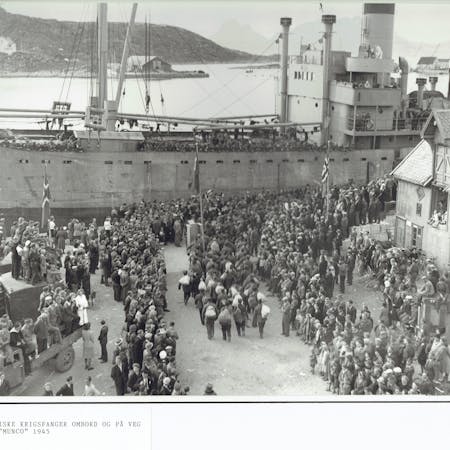
Soviet Prisoners of War on their way aboard "Mungo" in Bodø for their lengthy, but long-awaited journey back to their motherland. (Photo: Trygve Romsloe)
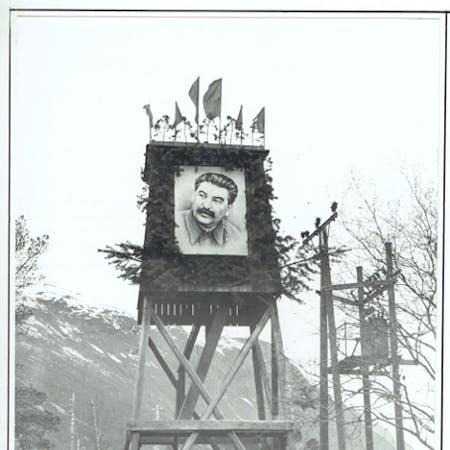
A watchtower with a picture of the prisoners' leader, Josef Stalin, decorated with flags and twigs probably did a lot for the morale among the prisoners. (Photo: Trygve Romsloe)
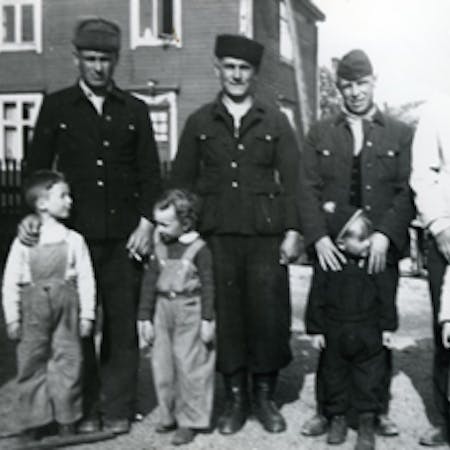
The longing for their own families, and perhaps especially for their children, was probably hard for the Soviet Prisoners of War. Here are some of them posing with four local children. From the left: Thor F. Eriksen, Per Wangberg, Knut Hagen and Erik Munkvold. (Photo: Narvik War Museum)
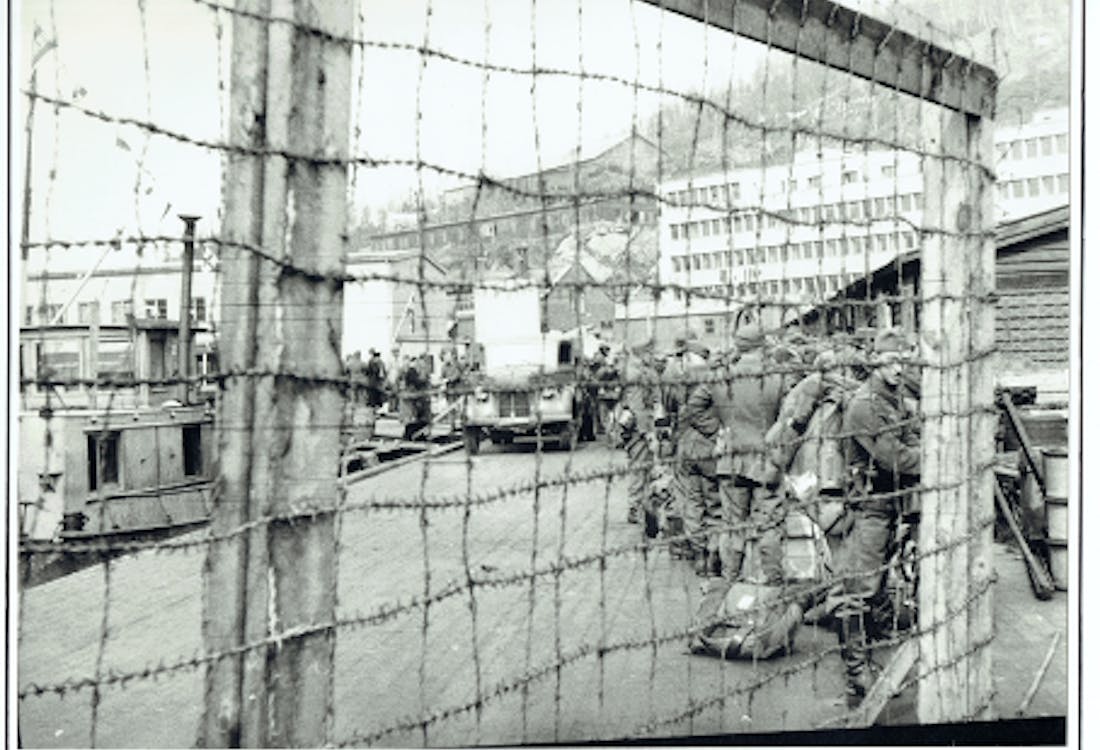
The disarmed German soldiers in Norway are divided into working groups and set to clear minefields and exhume the bodies of the prisoners their regime has sent to death. The roles have been reversed and few feel sorry for the former occupier.
Still, the locals have lived side by side with the Germans for five years. They have visited the same cafes, walked the same streets, and shopped at the same shops. Many families have had to share their house with soldiers occupying rooms or floors, and many have worked for the Germans. The soldiers were perceived as enemies and threatening masters, but also as neighbours, customers, friends, and lovers. Nightmares and adventures.
In late summer, the repatriation begins. 30,000 Germans leave Norway via Narvik, by ship or by train.
“… Tomorrow a British destroyer, Hotspur, is coming. Then we shall fly flags and sing songs once more. Almost every day is 17 May. It can’t be fun for the Germans seeing all these happy people.” (Diary of Greta Dahl, 26 June, 1945)
Klikk for større bilder
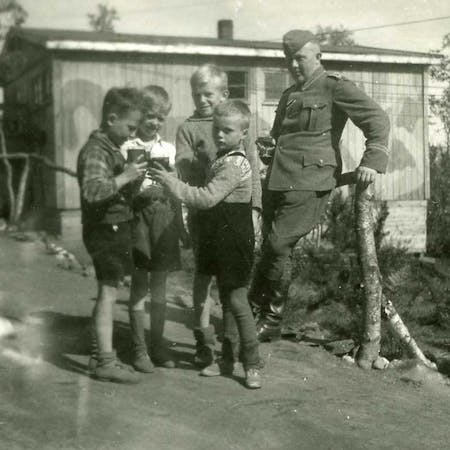
Many of the German soldiers have been in Norway for a long time when the war ends, and surely miss their families back home. Cheering up local children with sweets and other scarcities might have helped lift their spirits while waiting to return home. (Photo: Narvik War Museum)

German soldiers marching down to the port of Narvik to be repatriated. Order and discipline still need to be maintained among the large number of soldiers about to leave the city, although many of them probably cannot get home fast enough now that the war is over.
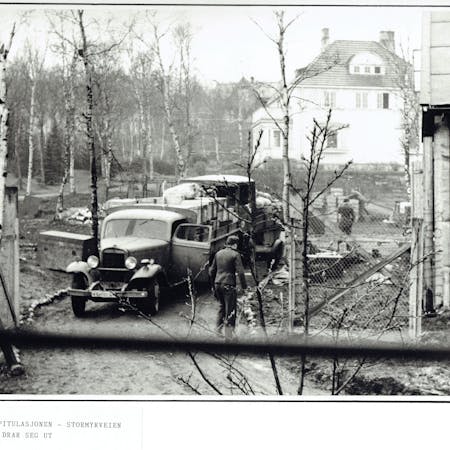
Many German soldiers have been housed in private homes for a long time. In some cases, they have taken over the whole house, and thus displaced the family who used to live there. Others have had soldiers occupying an entire floor or some rooms of their house while they still lived there themselves. When liberation comes, the Germans are told to withdraw from private homes as well, here from a home in Stormyr Street in Narvik.
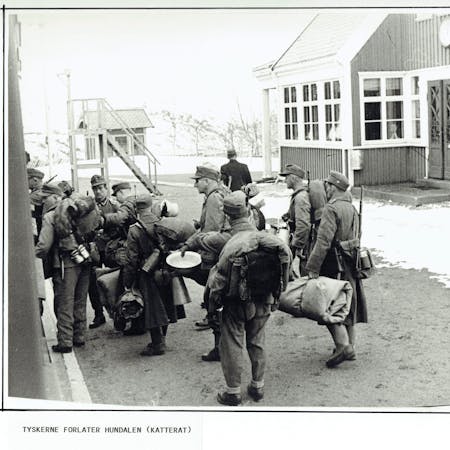
German soldiers leaving Hundalen near Katterat by train. Some soldiers have collected valuable items throughout the war to take home, others pack as much equipment as they can for the transport home. Others leave more or less everything behind, simply happy that the war is over so they can finally go home. (Photo: Trygve Romsloe)
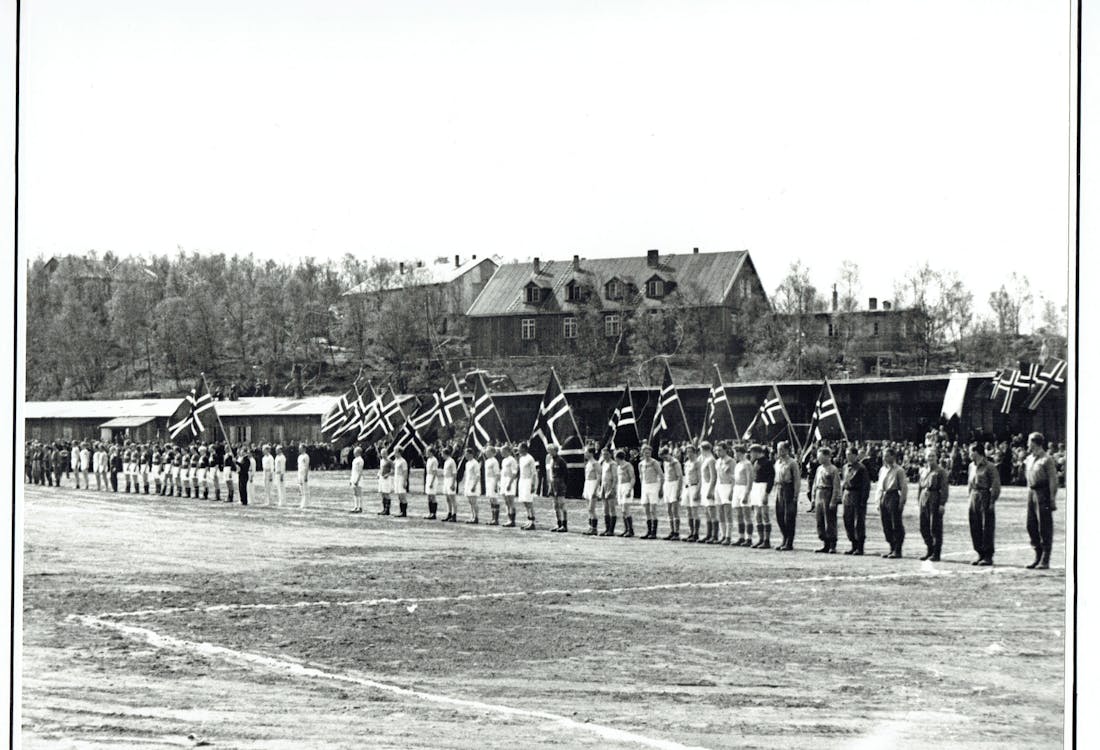
It is Sunday and people gather at Narvik Stadium. It is the athletes’ turn to celebrate after ceasing all activity during the occupation. The event begins with the gymnasts’ best performances; they still remember their moves. The football teams Mjølner and Brandt meet for a match which ends 2–1. Sixty metres race, pole vault, handball, and wrestling follow. At the end everyone joins in singing “The King’s Song.”
The city’s chess club organises international team tournaments. The Soviets from the Beisfjord camp field a team of 15 men, led by the great player Kranid. The Poles, the Dutch and the Czechoslovakians also take part, and the Norwegian police soldiers eagerly throw themselves into the competition. The spirit of sportsmanship strengthens the sense of community across the nations.
The events are lined up. The Norwegians imprisoned in Germany during the war are greeted with cheers upon returning. The bus to Harstad is back in regular route. The barbed wire fences the Germans put up everywhere are taken down. Summer is coming.
Excerpt from the local newspaper Fremover, 18 May 1945:
“Sports greetings from Sweden.
The chairman of the Northern Norway Sports Federation has received the following telegrams, showing the joy across the border that our country and thus the sports are free once more.
“To all sports associations in Narvik on the first day of peace, we want to express our best wishes to you, our Norwegian sports comrades. Our hope is that we will meet again soon in the peaceful practice of sports.”
The Sports Associations’ Cooperation Committee in Kiruna “
Klikk for større bilder
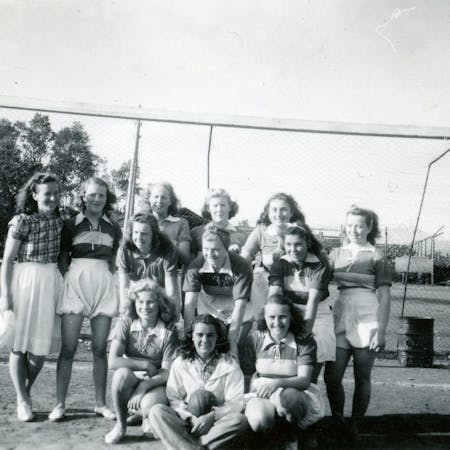
The women's handball team Mjølner was likely established in 1945, and consisted of Titti Pleym, Sussi Pedersen, Marit Røger, Turid Korgen, Jorun Hansen, Randi Trætteberg, Inger Bogen, Synnøve Bjørgan, Elna Dahl, Inger Wist, Signe Solberg and Solveig Edvardsen. The team was active until 1948/49. (Photo: Narvik War Museum)
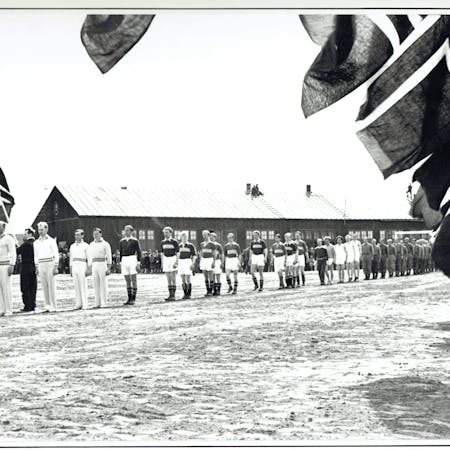
"The sport events. Sunday will be one of the biggest sport events Narvik has ever seen. It starts with a parade from the town square at 1 PM, with all the athletes, old and young, passive and active members of all clubs, to the Stadium, where about 120 athletes will show that the sports are not dead despite of the strike. Admission to the Stadium is free for everyone." (From the local newspaper Fremover, 1 June 1945)
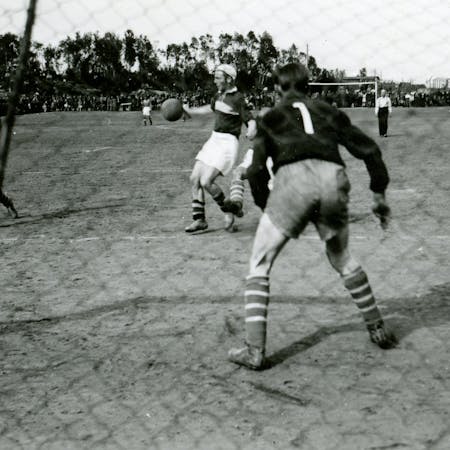
Nothing to say about the joy and enthusiasm for sports in the spring of 1945, here represented by a friendly football match. The competitive instinct has clearly survived through five years of German occupation, as the goalkeeper refuses to gift any easy goals. (Photo: Narvik War Museum)
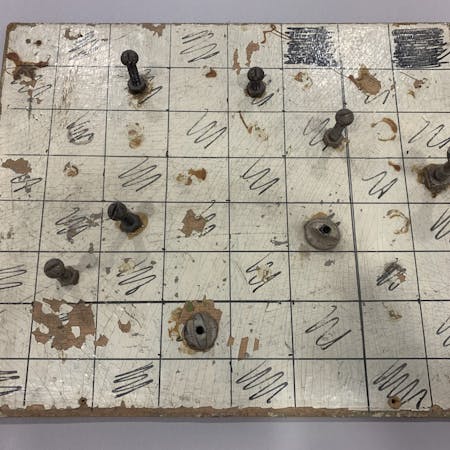
Many of the Soviet Prisoners of War in the Beisfjord prison camp are creative craftsmen and avid chess players, so naturally they make chessboards. In the absence of complete sets of proper chess pieces, screws, nuts and bolts and other small objects must do the trick. (Photo: Narvik War Museum)
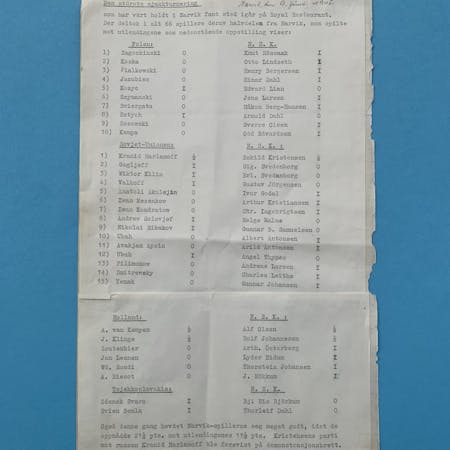
While awaiting repatriation after the liberation, the Soviet Prisoners of War organise a chess tournament to pass time and have some proper entertainment. Here is the first part of the results list from the chess tournament held in Narvik on 9 June 1945. (Photo: Narvik War Museum)
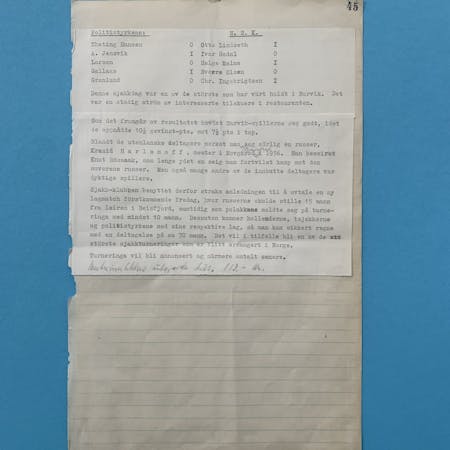
Part two of the results list from the chess tournament held in Narvik on 9 June 1945. The prize for winning, other than honour and glory, is not known. (Photo: Narvik War Museum)
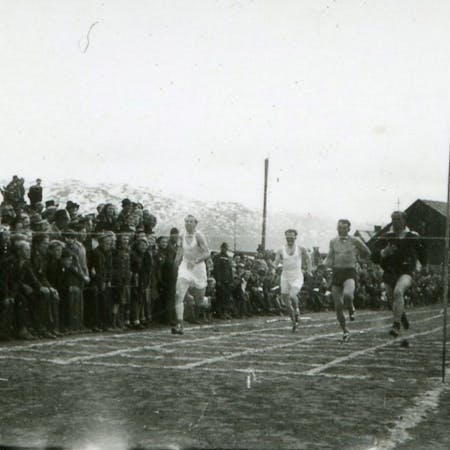
"The athletes celebrate their victory. Great sports event yesterday. Great achievements by Erling Kås. For five long years of war, all public sports have been discontinued. The athletes have kept a great unbroken front in the fight against Nazism. Now one can once again start with fresh forces. The sports event here in the city yesterday was a promising start to the work ahead"......" The finals of the 60 m. race took place during the break. Erling Kås won with a time of 7,9. The other results: 2. Larsen 8,00, 3. Nilsen 8,1, Kristoffersen 8,1." (From the local newspaper Fremover, 4 June 1945. Photo: Trygve Romsloe)
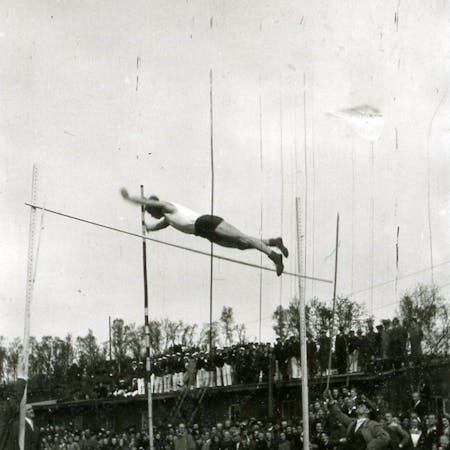
"An exercise that really caught the interest of the audience was the famous pole vaulter Erling Kås' elegant leap. That he yesterday reached a result of 3,85 m. without having competed for a long time signals a brilliant new season if he gets the chance to practice. He is currently serving in the military... "(From the local newspaper Fremover, 4 June 1945. Photo: Trygve Romsloe)
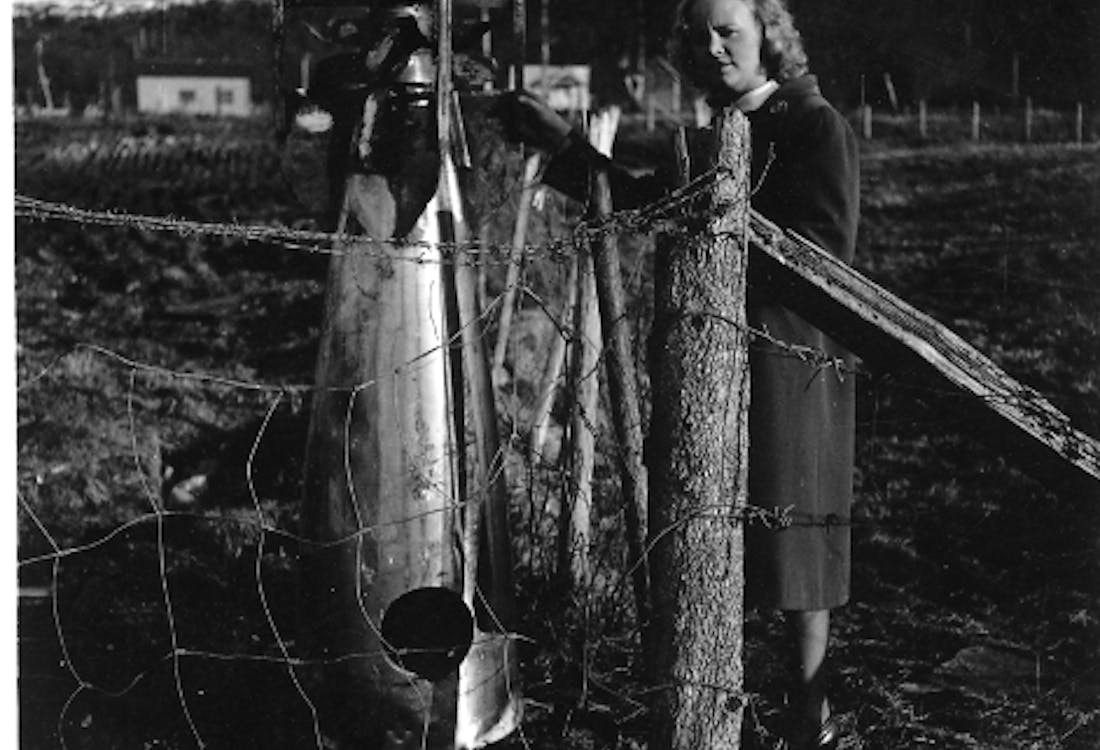
The rationing continues and it will be long before the supply of goods is large and stable again. Many restrictions will last for years. The housing shortage in the city is precarious, the harbour is filled with wrecks, the fjord filled with mines. Heavy lifts and clean-ups are needed.
Nevertheless, the economy is in good condition. Municipal and personal debts are greatly reduced, and businesses and banks have been saving money for a rainy day. The reconstruction can begin.
British troops replace the Norwegian police soldiers and keep control of the booty. Most of the Germans’ military equipment and weapons are destroyed, despite Norwegian authorities’ hope of keeping the goods.
It is a strange time.
From the local newspaper Fremover, 6 June 1945:
“Announcement.
It is emphasised that under the conditions of capitulation, all sales of German property and assets of any kind, whether they belonged to the German Armed Forces or its officers and privates or civilians, are strictly prohibited. Also, the buyer will be guilty of a criminal act and the illegally bought items will be confiscated from the buyer and the person to whom resale may have taken place. Section Command Narvik, 3 June 1945.”
Klikk for større bilder
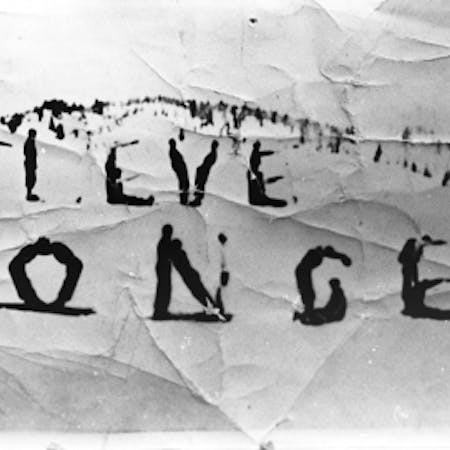
"Live the King."
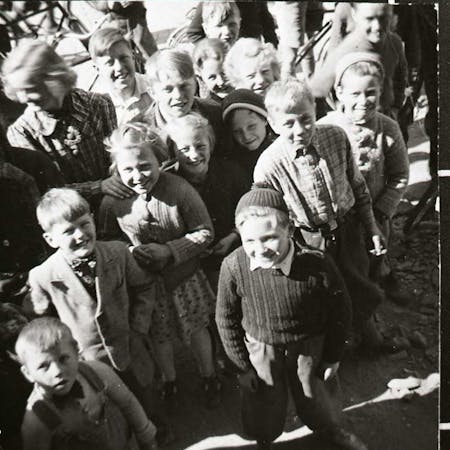
After close to five years of occupation, maybe especially the children who have not experienced anything else are excited for this thing called “liberation.” Here illustrated by an excited group of children in Narvik. They have probably never before taken part in such a joyous celebration as the one held on 7 June 1945. (Photo: Narvik War Museum)
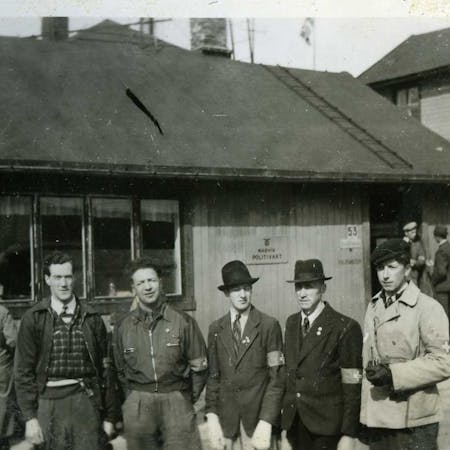
Ingvald Hope (to the left), here on assignment from the Home Forces, poses with others from the Home Forces in front of Narvik Police Station. Popularly called “Finka”, several local men and women were held in custody here during the war, suspected of being part of the resistance. Now that the liberation has finally arrived, those days are over. (Photo: Narvik War Museum)
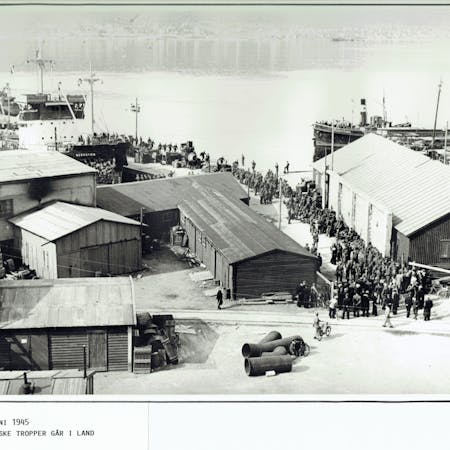
British troops arrive in Narvik. They will relieve the Norwegian soldiers from the work of cleaning up German war materials and remnants. Now, they will march to Haakonshallen in Narvik, a great hall built by the German occupants during the war. Then called Soldatheimen – “The Soldiers Home”, the name is changed to “Haakons Hall”, as a tribute to King Haakon. (Photo: Trygve Romsloe)
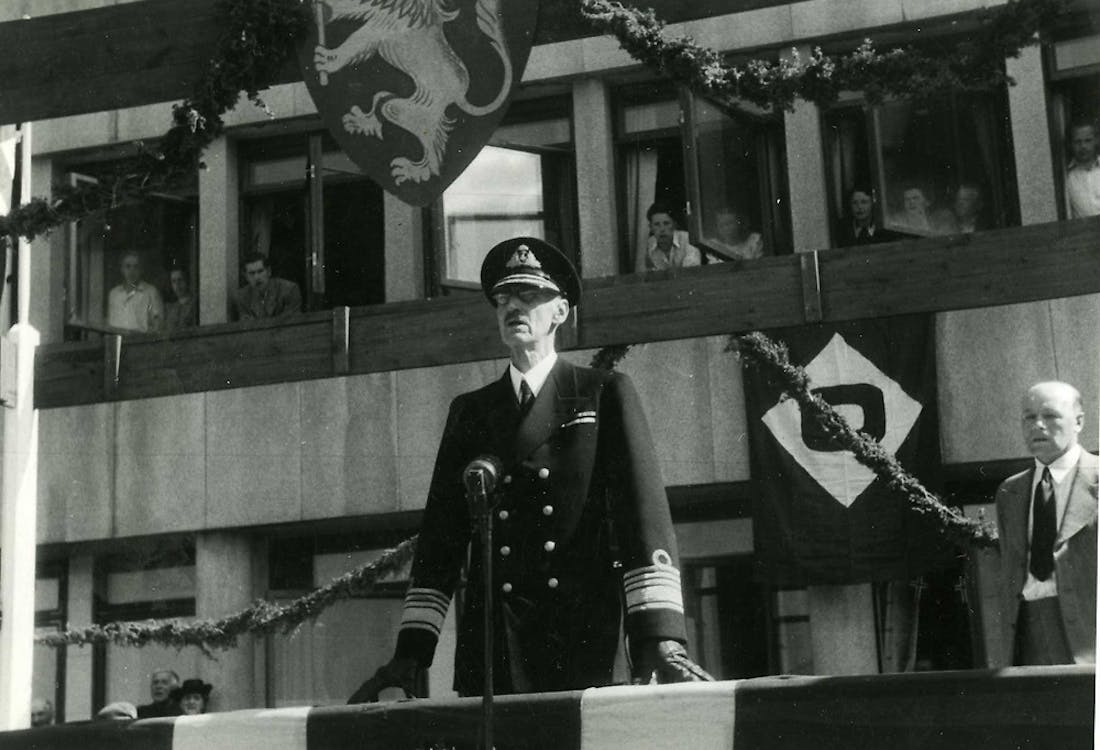
Since the German capitulation a month ago, the Allied High Command has formally held the supreme authority in Norway. But King Haakon VII is back on Norwegian soil. The King and his people are reunited.
King Haakon has been the unifying national hero, the very symbol of the struggle for freedom during the occupation.
The mountains of Northern Norway were the last he saw of his beloved country before evacuating to London on 7 June 1940 aboard HMS Devonshire, together with the rest of the Royal Family and the Norwegian Government. They have remained in exile in London throughout the war. The King’s return to Oslo and Norway exactly five years later, on 7 June 1945, is celebrated all over the country from morning until evening.
The following year, in the summer of 1946, a long-awaited ship glides into the Ofotfjord. King Haakon is onboard. The tall monarch disembarks and looks around at the place where the fight against the Nazis caught its first glimpse of hope. The city with a name now known all over the world – Narvik.
From the local newspaper Fremover 28 May 1945:
“Greetings from Crown Prince Olav.
In response to a greeting telegram to the Chief of Defense, Crown Prince Olav, Narvik municipality has, through the Mayor, received the following greetings: “I send my warmest gratitude to the city of Narvik for its efforts and greetings”. Olav.”
Klikk for større bilder
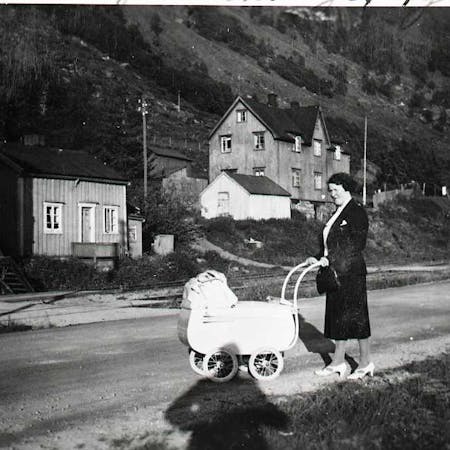
A mother pushes a pram at Fagernes outside Narvik; life must go on both during and after the occupation. You can almost feel how the air has cleared up since the liberation, but the aftermath of the war will be felt for a long time: Rationing, clean-ups and reconstruction will mark both the city and the country for years to come. (Photo: Narvik War Museum)

Crown Prince Olav, appointed Chief of Defense in 1944, has led the Norwegian forces and cooperation with the Allies up until the liberation. Here he is welcomed to Narvik on 23 July 1945, to great cheers from the curious spectators. (Photo: Narvik War Museum)
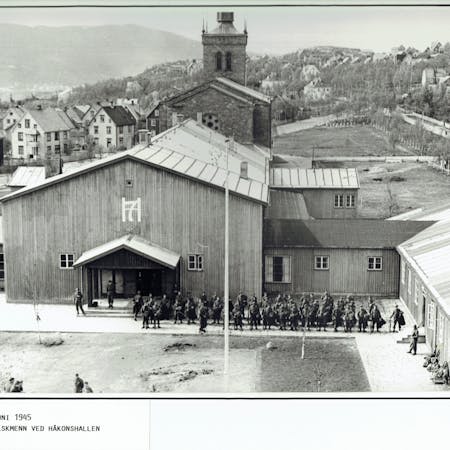
British soldiers at Haakonshallen, located at Frydenlund in Narvik, 8 June 1945. Haakonshallen now holds the monogram of King Haakon VII over its entrance, a symbol fit for the occasion. Narvik church is seen in the back. (Photo: Trygve Romsloe)
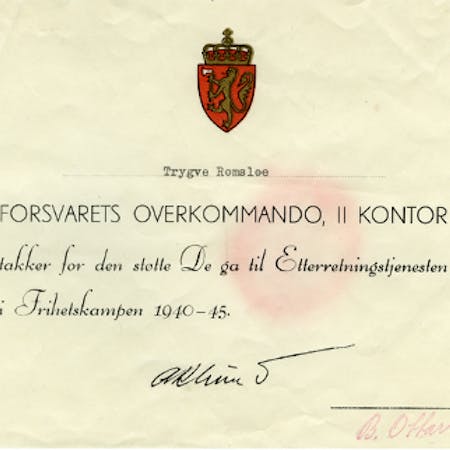
Narvik War Museum is most grateful to have received photographer Trygve Romsloe's collection of photos from the days of the liberation. The unique photos we have shown in this exhibition would not have been possible without Romsloe's photographs. We are also grateful for the helpfulness and welcoming attitude towards our work shown by Romsloe’s descendants. (Photo: Narvik War Museum)